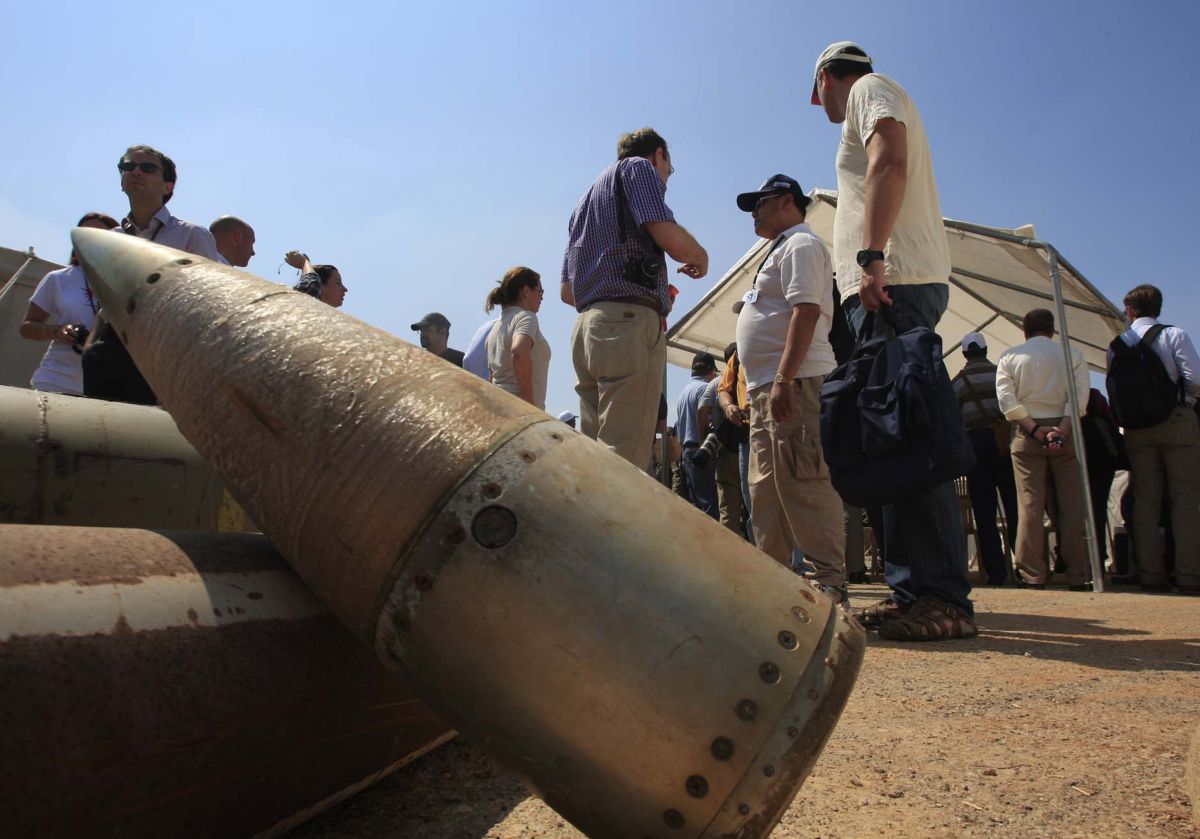Stand up for the facts!
Our only agenda is to publish the truth so you can be an informed participant in democracy.
We need your help.
I would like to contribute

U.S. Air Force Brig. Gen. Patrick Ryder, a Pentagon spokesman, holds a media briefing where the transfer of cluster munitions to Ukraine was discussed, July 6, 2023. (AP)
If Your Time is short
-
Cluster bombs, which date back to World War II, are weapons designed to split into smaller bombs in the air, exploding over an area as wide as 7 acres.
-
Military experts say cluster bombs — also called cluster munitions — can be an effective battlefield tool, especially for the types of scenarios Ukraine is facing against Russia, such as fighting off soldiers embedded in trenches or riding in armored vehicles.
-
Critics argue that these weapons can kill civilians years after wars are over, as unexploded “bomblets” lurk in places where civilians, and even children, can inadvertently disturb them, leading to injury or death.
In a decision that has drawn criticism from human rights advocates and even some U.S. allies, the Biden administration said July 7 that it would include cluster bombs in a new $800 million security package for Ukraine.
Cluster bombs, which date back to World War II, are weapons designed to split into smaller bombs in the air, exploding over an area as wide as 7 acres.
Military experts say that cluster bombs — also called cluster munitions — can be an effective battlefield tool, especially for the types of scenarios Ukraine is facing against Russia, such as fighting off trench-embedded soldiers.
Ukrainian President Volodymyr Zelenskyy had pushed for the U.S. weapons transfer, saying it would help "bring Ukraine closer to victory over the enemy, and democracy to victory over dictatorship."
Critics, however, argue that these weapons can kill civilians years after wars are over, as unexploded "bomblets" lurk in places where civilians, adults and children, can inadvertently disturb them, leading to injury or death. These unexploded bomblets are called duds.
"Because they are light, duds tend to lie on the surface or close to it, where civilians can step on them after military operations in that area are completed," said Brendan Green, an associate professor at the University of Cincinnati's School of Public and International Affairs.
Since 2008, more than 120 countries have joined the Convention on Cluster Munitions. Signatories agree to not use, produce, transfer or stockpile such weapons. However, the United States, Russia and Ukraine have not signed this convention.
The 2022 monitoring report of the International Campaign to Ban Landmines-Cluster Munitions Coalition said 97% of cluster bomb victims in 2021 were civilians, 66% of those were children.
"Human Rights Watch is appalled by the decision to transfer cluster munitions to Ukraine due to the likelihood of civilian harm," said Mary Wareham, advocacy director of Human Rights Watch’s arms division. "Even if the U.S., Ukraine and Russia are not part of the convention, this will disrupt the international consensus."
Here’s a rundown of what the Biden administration has done, some background information about cluster bombs, and a look at the ethical conundrums surrounding their use.
Military experts say cluster munitions are effective against infantry, artillery and vehicle convoys.
"Because cluster munitions spread bomblets over a wide area, a single munition can cover the same area as many unitary projectiles," said Mark Cancian, a senior adviser with the Center for Strategic and International Studies, a Washington, D.C.-based think tank. (Unitary projectiles are munitions that include just one explosive element, rather than dozens for cluster munitions.)
With the Russians "hunkered down in trenches, air-burst fragmentation submunitions" — cluster bombs — "are the best way to kill them," added John Pike, director of globalsecurity.org, a Washington-based research group.
Although multiple bomblet hits could destroy an armored vehicle, even one hit could disable it, military experts said.
Cluster bombs pack delayed risks, but they also provide an ironic benefit, of efficiently clearing minefields, which is a painstaking, dangerous job when done by hand.
"Mines have been giving the Ukrainians fits," said Lance Janda, a military historian at Cameron University. "It’s way easier to detonate a cluster munition that will separate into, say, 88 submunitions that also detonate all or at least most of the mines in an areas the size of a football field or larger."
Biden has had a complicated history with cluster bombs. (More on that shortly.) In the Ukraine case, he expressed ambivalence about the weapons to CNN, saying, "It took me a while to be convinced to do it." He said he ultimately followed the Defense Department’s advice.
U.S. officials have said the types of cluster munitions the U.S. cleared for transfer — known as dual-purpose improved conventional munitions, or DPICMs — have lower "dud" rates, which reduce the likelihood of delayed civilian casualties. Colin Kahl, the U.S. defense undersecretary for policy, said at a Pentagon briefing that the rate of unexploded duds would be less than 2.35%, compared with rates approaching 40% for less advanced versions in use, based on U.S. studies from 1988 to 2020.
"We recognize the cluster munitions create a risk of civilian harm from unexploded ordnance," National Security Adviser Jake Sullivan said at a White House briefing. "This is why we’ve deferred the decision for as long as we could. But there is also a massive risk of civilian harm if Russian troops and tanks roll over Ukrainian positions and take more Ukrainian territory and subjugate more Ukrainian civilians, because Ukraine does not have enough artillery. That is intolerable to us."
U.S. allies have generally refrained from criticizing the Biden administration’s decision. NATO Secretary-General Jens Stoltenberg said he’s leaving the decision to provide cluster bombs up to individual member nations. A spokesman for the German government — which has signed the convention — deferred to the U.S., suggesting that Ukraine’s desire for the weapons was understandable considering that Russia has already used cluster munitions against Ukraine.
Military experts said that, for the moment, cluster munitions are the best option for aiding Ukraine’s military abilities, especially given the declining U.S. stockpiles of ammunition.
"The United States has committed over 2 million artillery shells to Ukraine, so U.S. stocks are now very low," Cancian said. "There is an ‘alternative warhead’ … that has effects similar to cluster munitions, but without the dud problem. However, the United States is already shipping those to Ukraine, and, because they went into production relatively recently, inventories are not large."
Steven Pifer, a former U.S. ambassador to Ukraine who is now at the Brookings Institution, a Washington-based think tank, framed cluster munitions as a transitional plan, mirroring BIden administration officials’ comments.
"Cluster munitions could provide a bridge to a later time when more unitary shells become available for Ukraine," Pifer said.
Activists and international delegations stand next to cluster bomb units Sept. 12, 2011. at a Lebanese military base. (AP)
As mentioned, Ukraine wouldn’t be the first side in the conflict to use cluster munitions: Russia has done so, according to Human Rights Watch, something Pike acknowledged.
"They already have cluster munitions — nasty, old, unreliable Soviet munitions — and have been using them already," Pike said.
Compared with these weapons, the new U.S. supplies should be less likely to cause civilian casualties, he said.
Also, Ukraine is under attack, wants the cluster munitions and would be using them on its own territory.
"Zelenskyy was democratically elected by a wide margin in a free and fair election, and is fighting a war that is supported by an overwhelming majority of the Ukrainian people," Pike said.
Ukraine would also take responsibility for cleaning up unexploded bomblets once the war ends.
"The Ukrainian government is prepared to take the risk because it places higher priority at this time on defeating the Russian military," Pifer said.
If sending cluster munitions to Ukraine is unethical, not doing so could also be considered unethicall, Green said.
"It seems unethical to force the Ukrainians to live with Russian occupation any longer than is necessary," he said.
Janda agreed with Green.
"If cluster munitions help end the war quickly, it’s a blessing," he said. "They may not — I don’t know. But if they could, it’s worth giving them a try and not holding back out of some false sense or morality that prolongs the war."
Using cluster munitions against enemy troops or vehicles is not illegal under international law, but civilian deaths from them could result in war-crime charges, experts said.
Proving and prosecuting those cases would be hard.
"War crimes are by individuals, so we have to have examples of the use of cluster munitions to even start talking about war crimes," Human Rights Watch’s Wareham said. "Was the target legitimate? Was caution taken to avoid civilian casualties? What warnings were made?"
Not only has the U.S. declined to sign the convention against cluster munitions — it has also used them in the past.
After the Persian Gulf War, for instance, there were at least 80 U.S. casualties and more than 4,000 civilians casualties from cluster munition duds, according to Human Rights Watch. Meanwhile, according to the Cluster Munition Coalition, the United States and the United Kingdom used nearly 13,000 cluster munitions in the three weeks of major combat in the Iraq War, and 1,228 cluster bombs in 2001 and 2002 in Afghanistan.
The U.S. never signed the convention against cluster munitions because "we think we need them," Janda said.
"And we think that primarily because we need them to defend South Korea, possibly Taiwan, and all of NATO in the event of World War III," Janda said. "We don’t always have to use them, and our military has enough options that we can work without them in most cases when needed, but we keep them for a reason."
The U.S. says it hasn’t used cluster munitions since the end of the Iraq War, and in 2016, the U.S. began to officially phase out their use. U.S. companies no longer produce them.
Biden has expressed concerns about cluster munitions but has never ruled out using them.
In the early 1980s, when he was a senator, for instance, Biden joined others in Congress to confront ethical questions about cluster munitions after reports surged of Israel using cluster bombs in the invasion of Lebanon.
More recently, The Washington Post, reported that Biden initially supported efforts to pull back cluster munition use but raised concerns over how it could affect the military, calling for hearings in 2006.
In fall 2006, two Senate Democrats introduced an amendment to eliminate the use of cluster munitions in areas with large populations. Biden was among 15 Democrats who voted against the amendment.
Our Sources
Defense Department, "Biden administration announces additional security assistance for Ukraine," July 7, 2023
CBS, "What is a cluster bomb, the controversial weapon the U.S. is sending to Ukraine?", July 7, 2023
Congressional Research Service, "Cluster Munitions: Background and Issues for Congress," March 9, 2022
Human Rights Watch, "Ukraine: civilian deaths from cluster bunitions," June 7, 2023
International Committee of the Red Cross, "Cluster Munitions," Oct. 13, 2022
Landmine and Cluster Munition Report, "Cluster Munition Monitor 2022," Aug. 25, 2022
The Washington Post, "Biden’s complicated history on cluster munitions," July 7, 2023
United States Senate, "U.S. Senate: U.S. Roll Call Votes 109th Congress- 2nd session," accessed July 10, 2023
AP News, "The US will provide cluster bombs to Ukraine and defends the delivery of the controversial weapon," July 7, 2023
Email interview with Brendan Green, associate professor at the University of Cincinnati's School of Public and International Affairs, July 10, 2023
Email interview with John Pike, director of globalsecurity.org, July 10, 2023
Email interview with Mark Cancian, senior adviser with the Center for Strategic and International Studies, July 10, 2023
Email interview with Lance Janda, military historian at Cameron University, July 10, 2023
Email interview with Steven Pifer, former U.S. Ambassador to Ukraine now at the Brookings Institution, July 10, 2023
Email interview with Michael O’Hanlon, senior fellow in the Brookings Institution’s foreign policy program, July 10, 2023
Interview with Mary Wareham, advocacy director of Human Rights Watch’s arms division, July 10, 2023






















